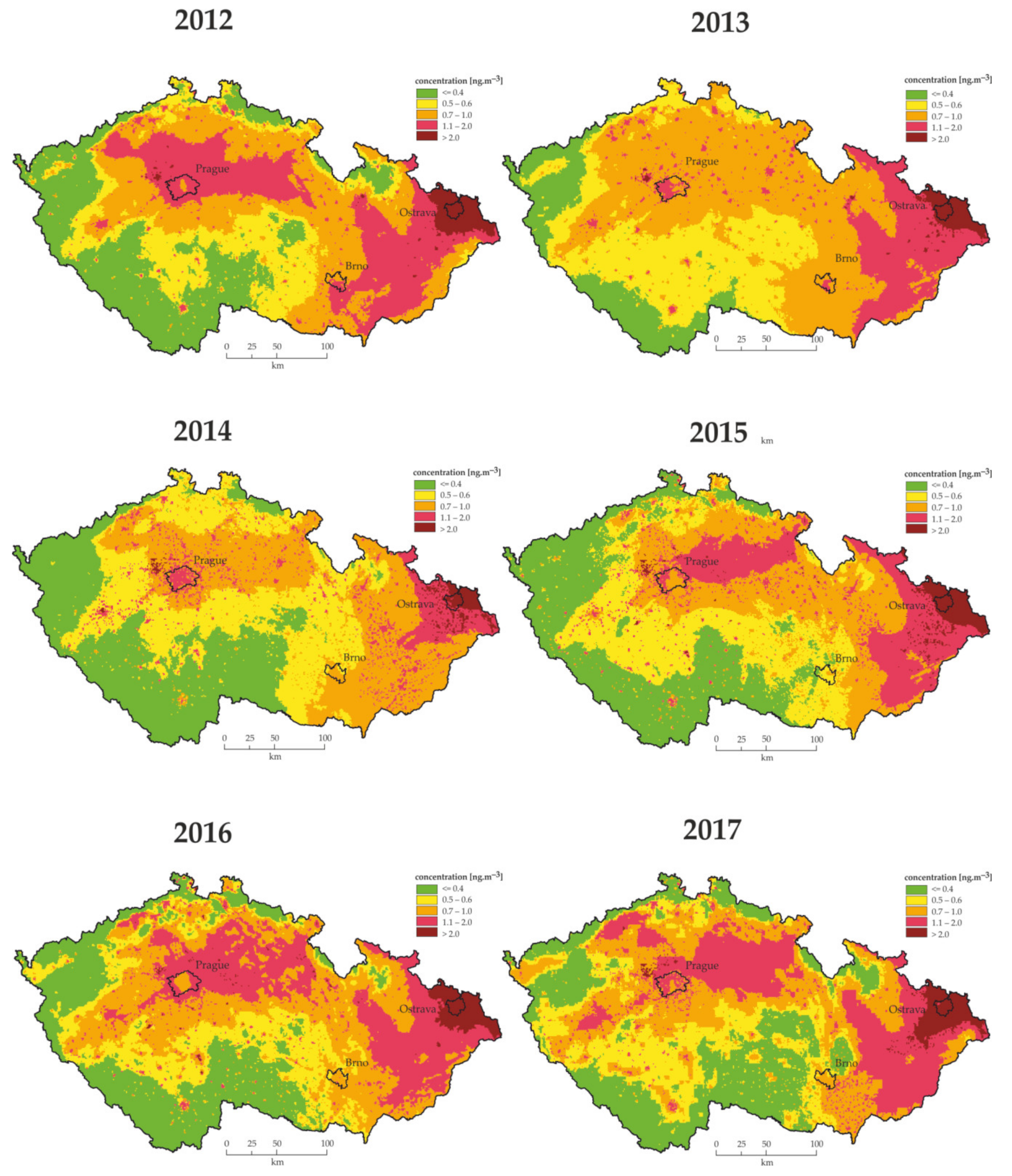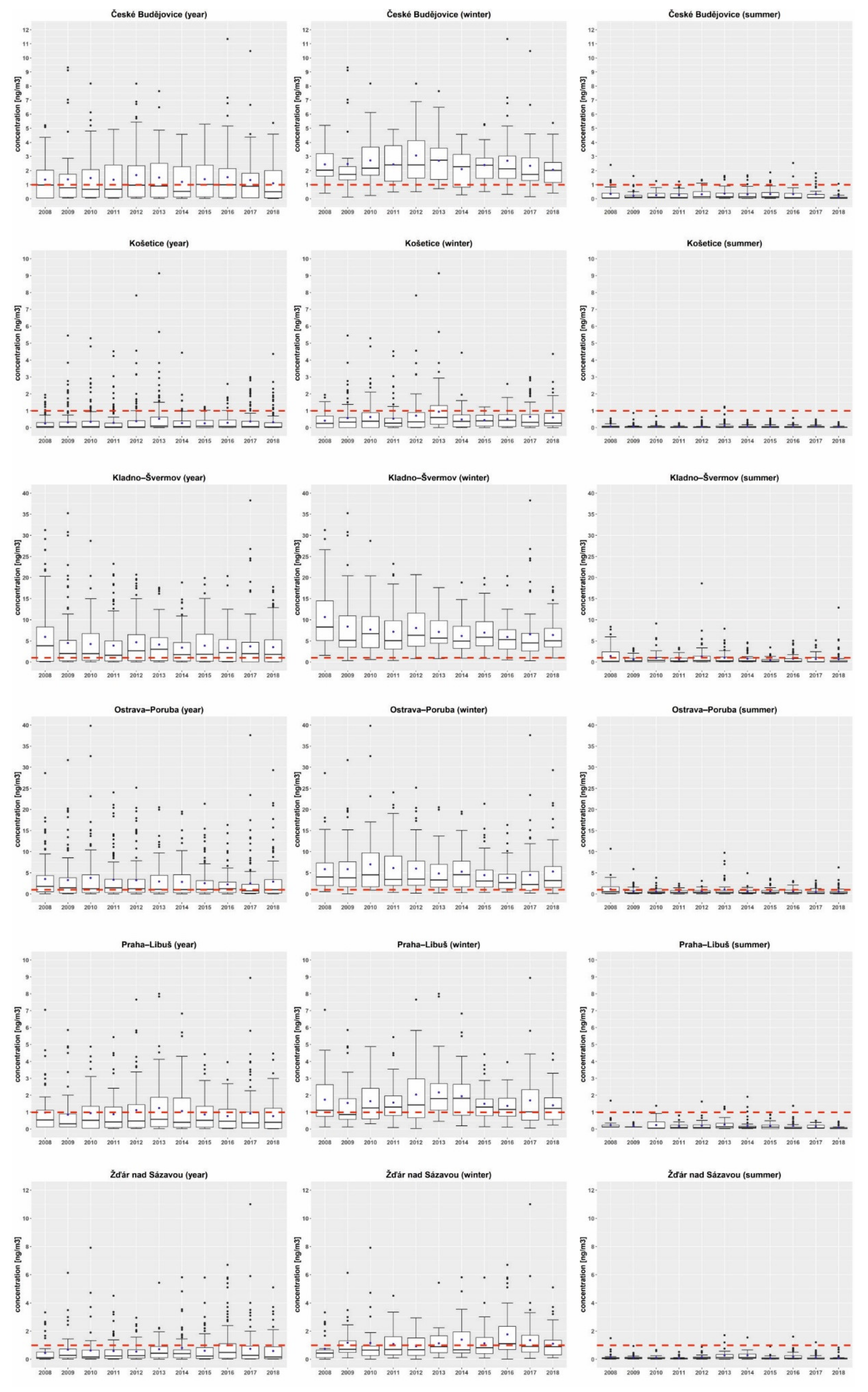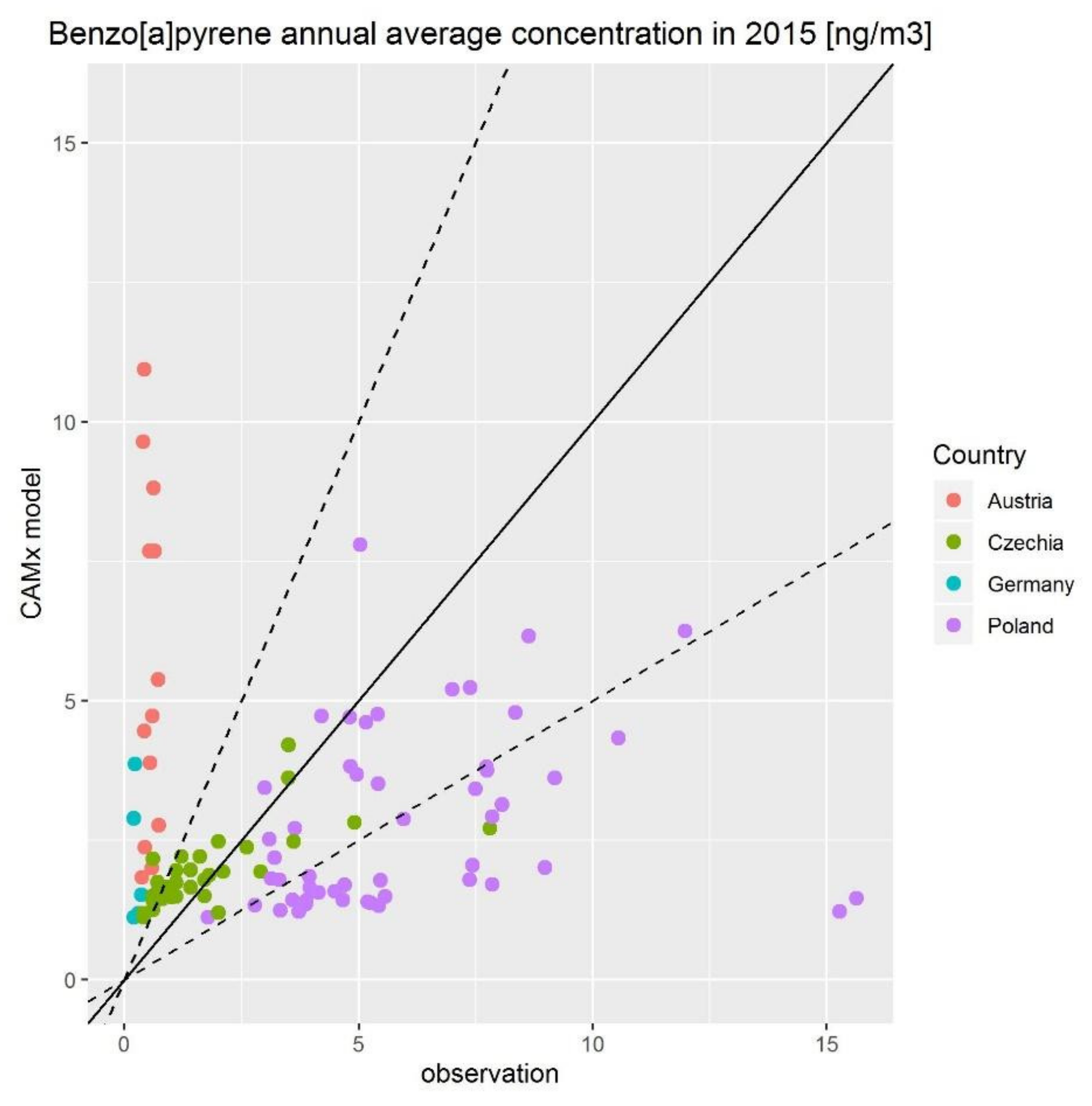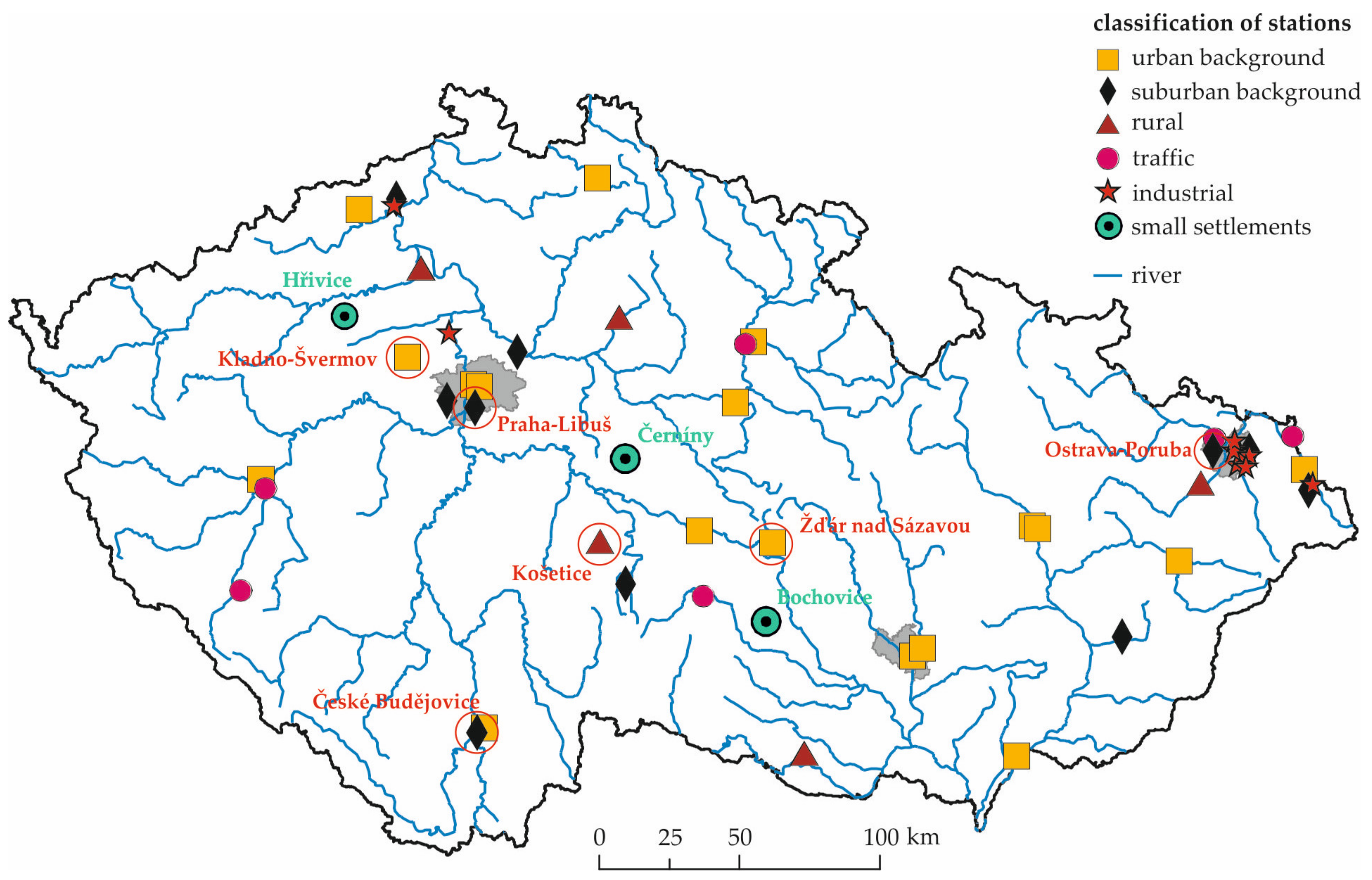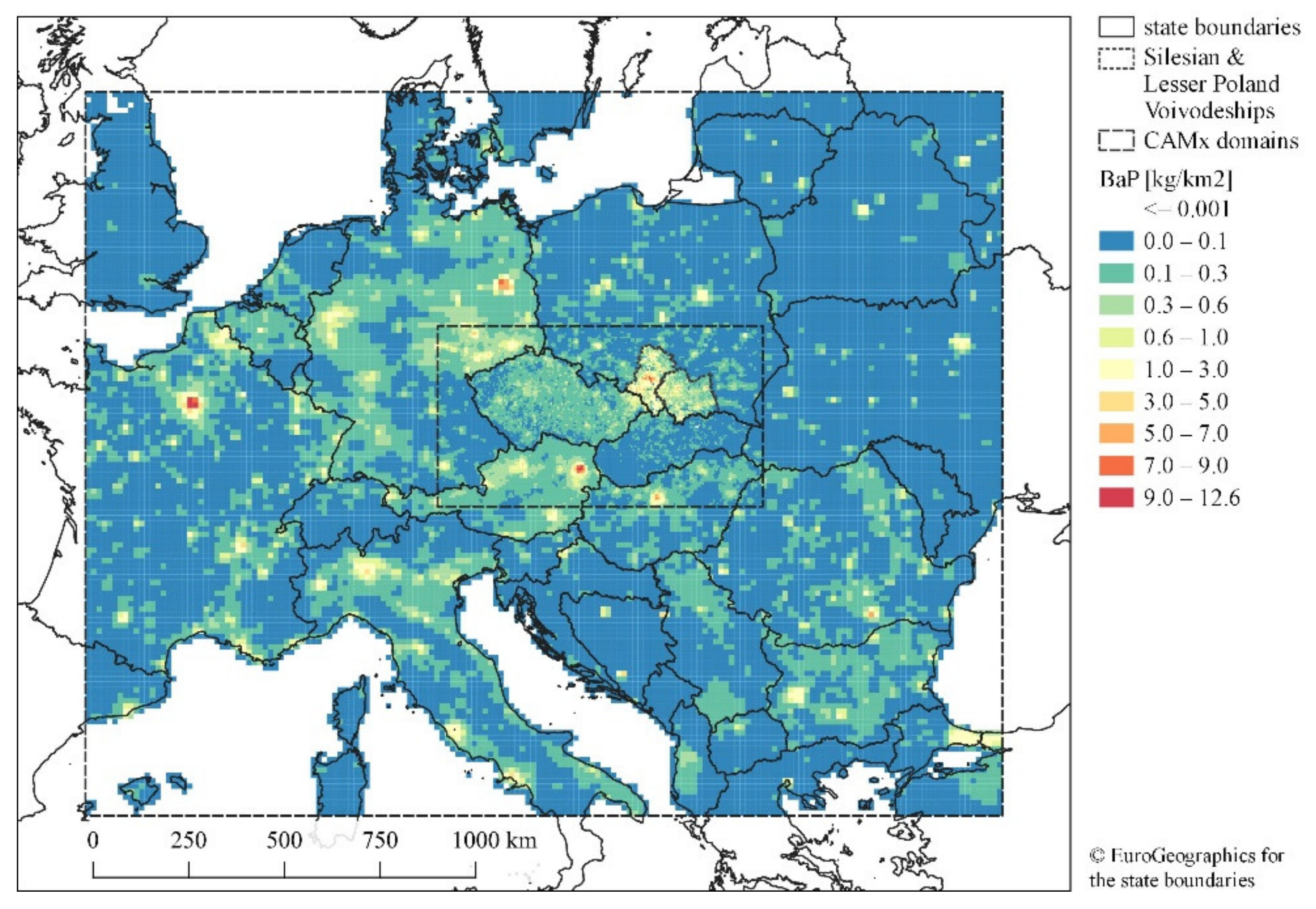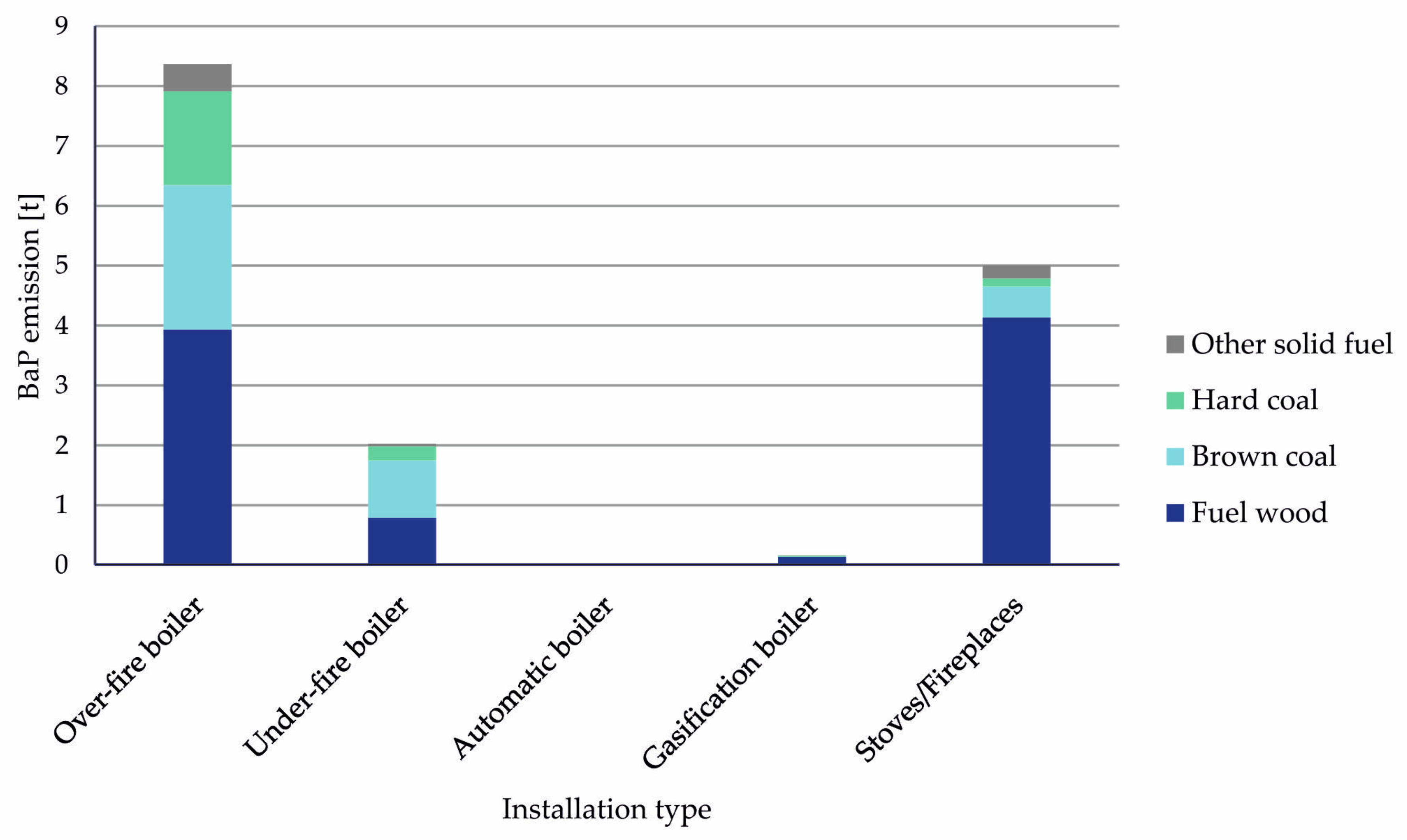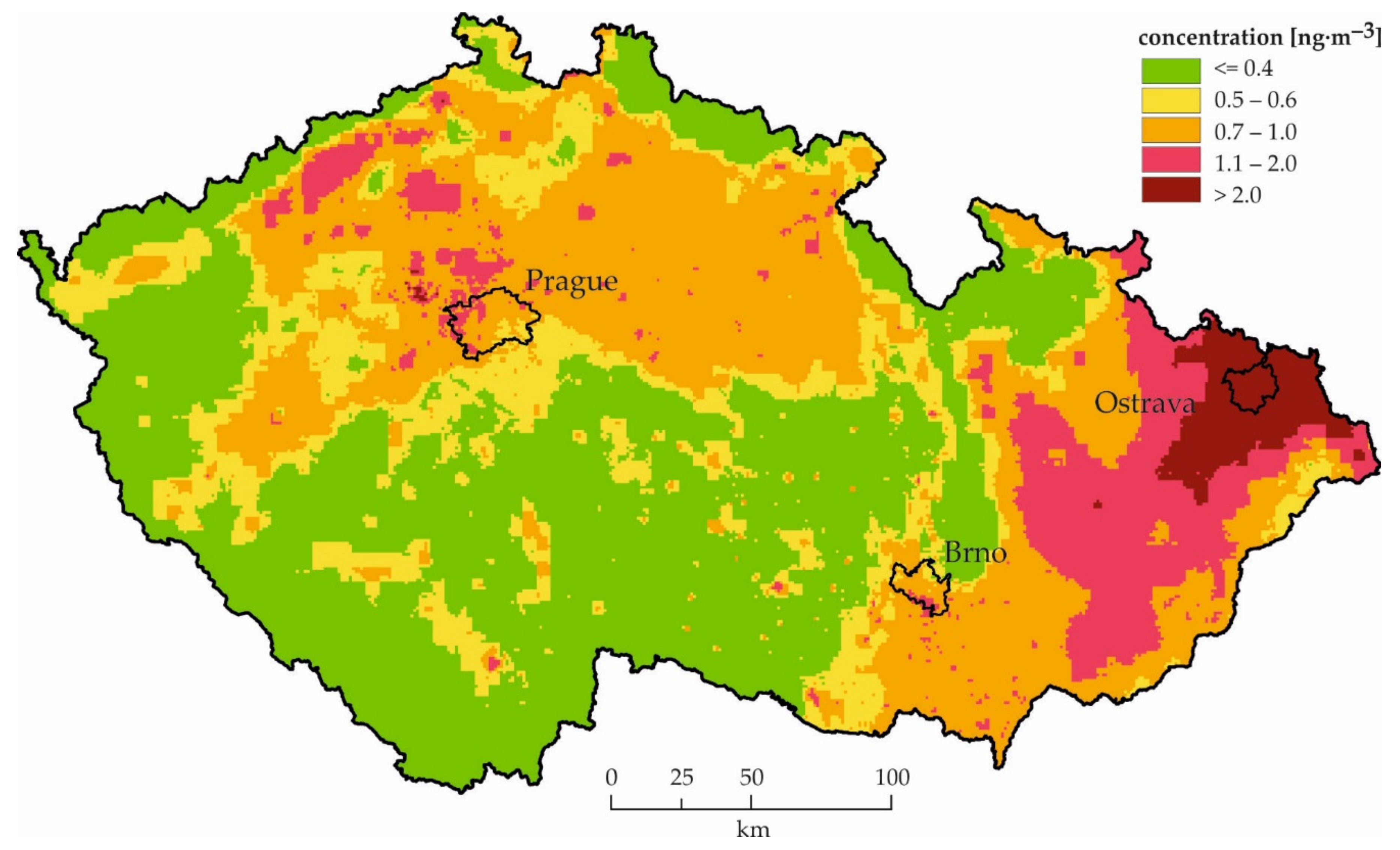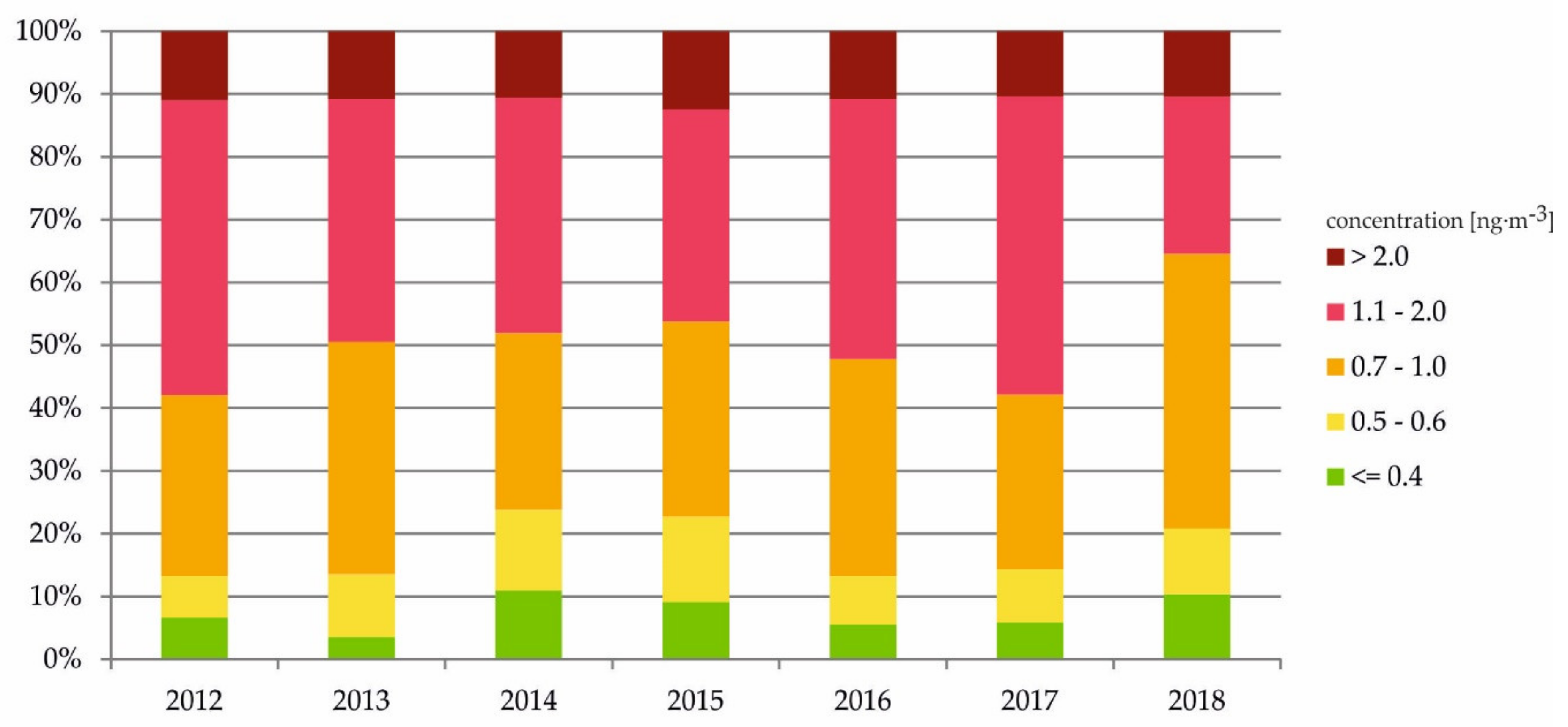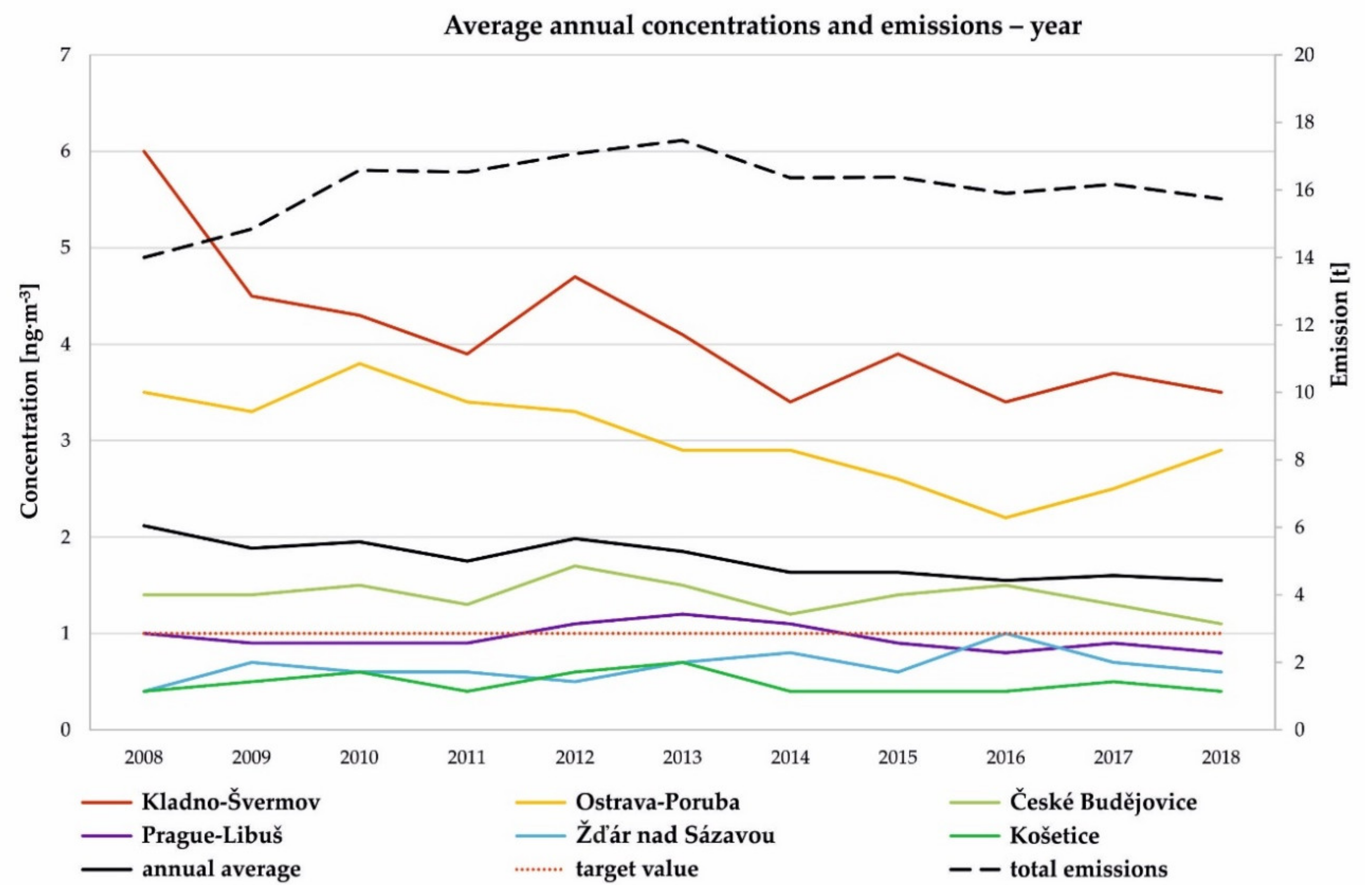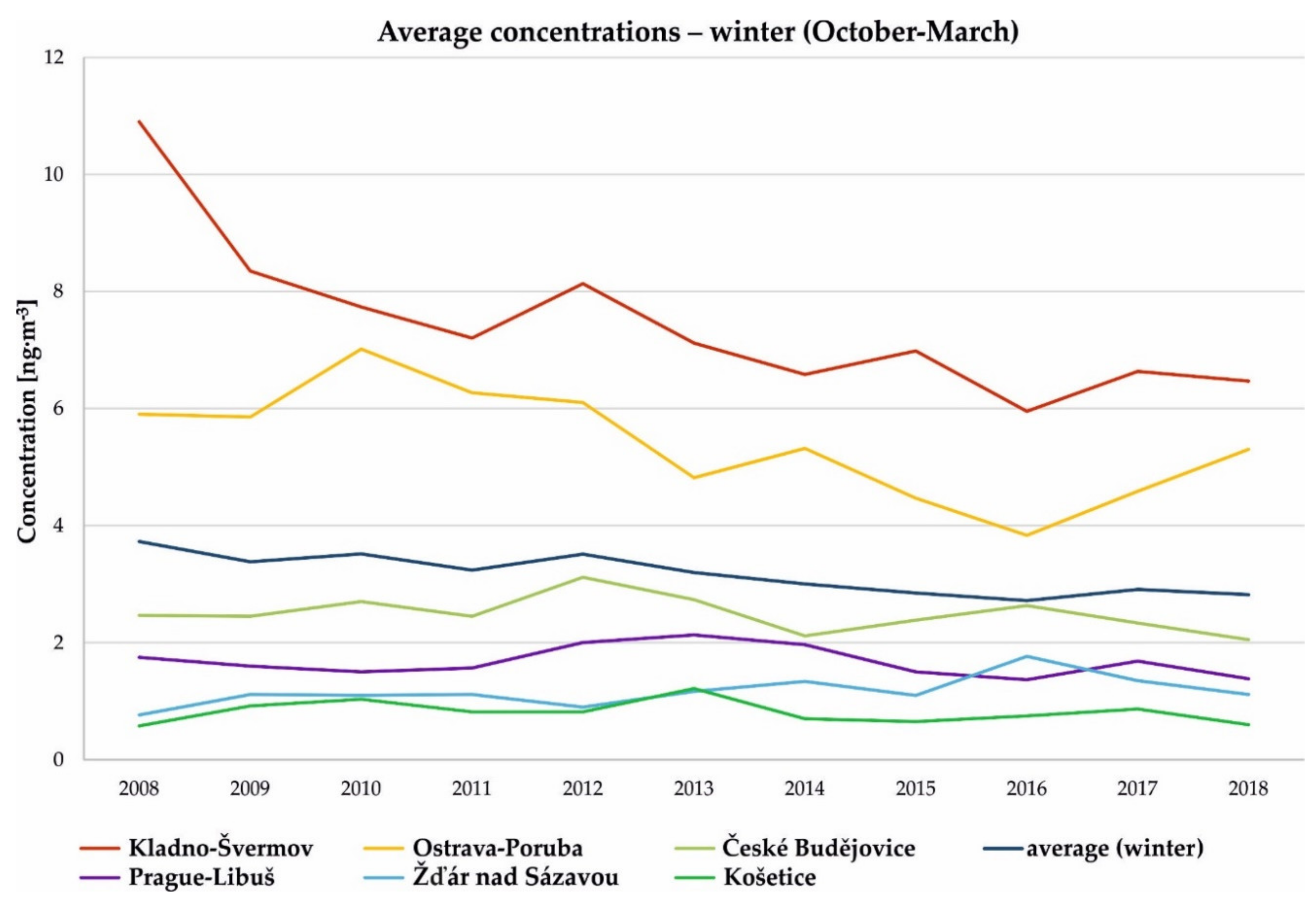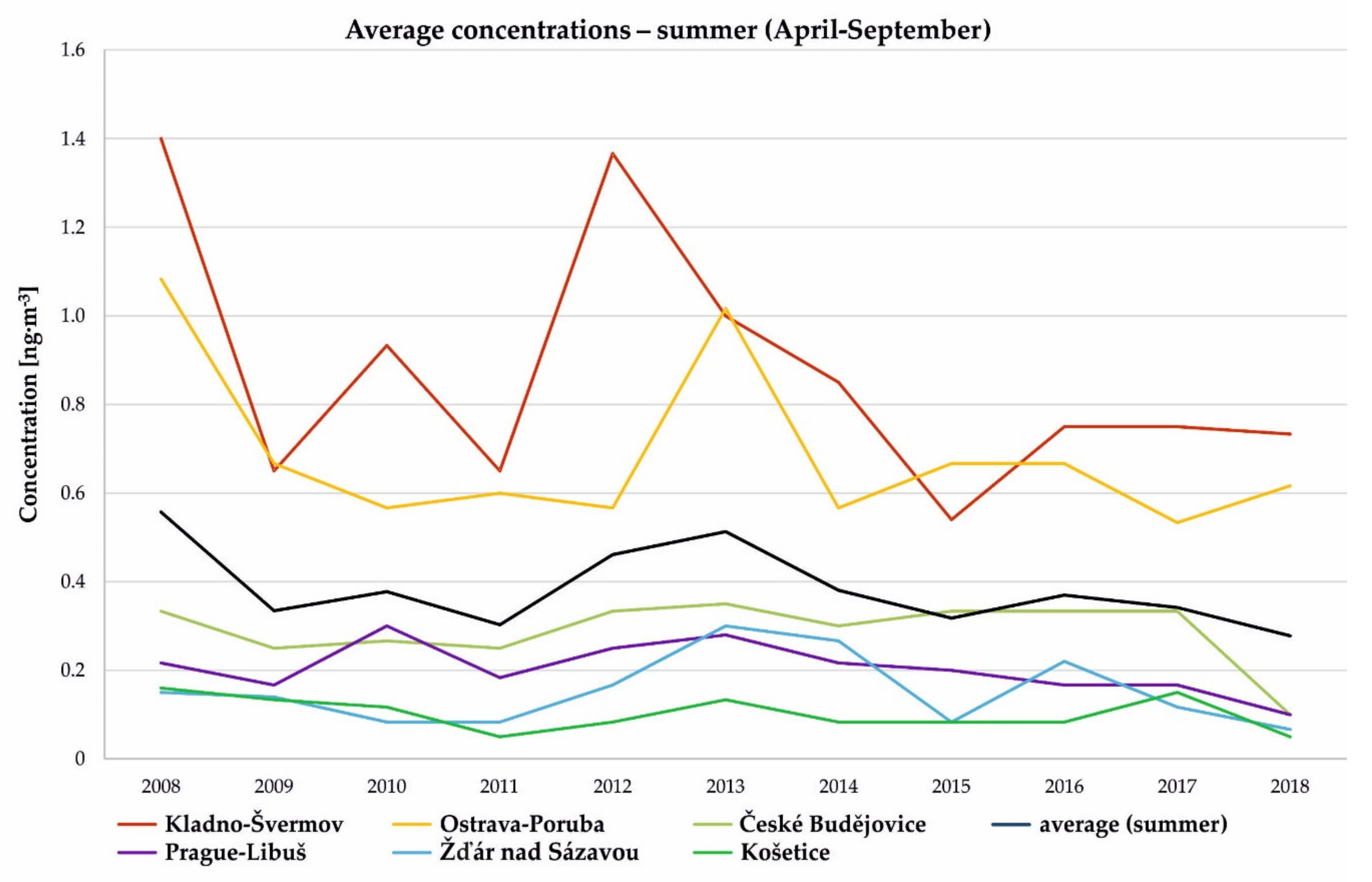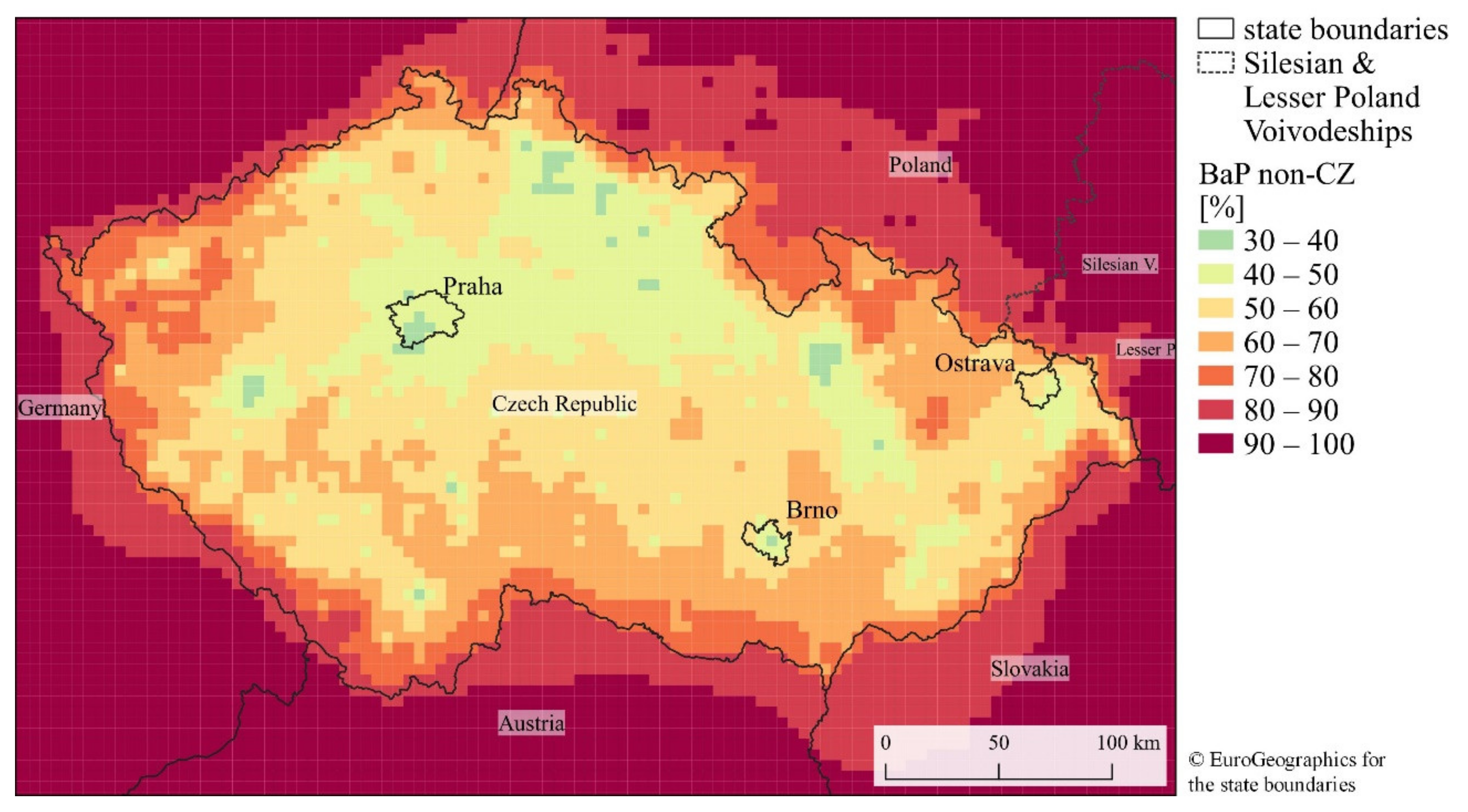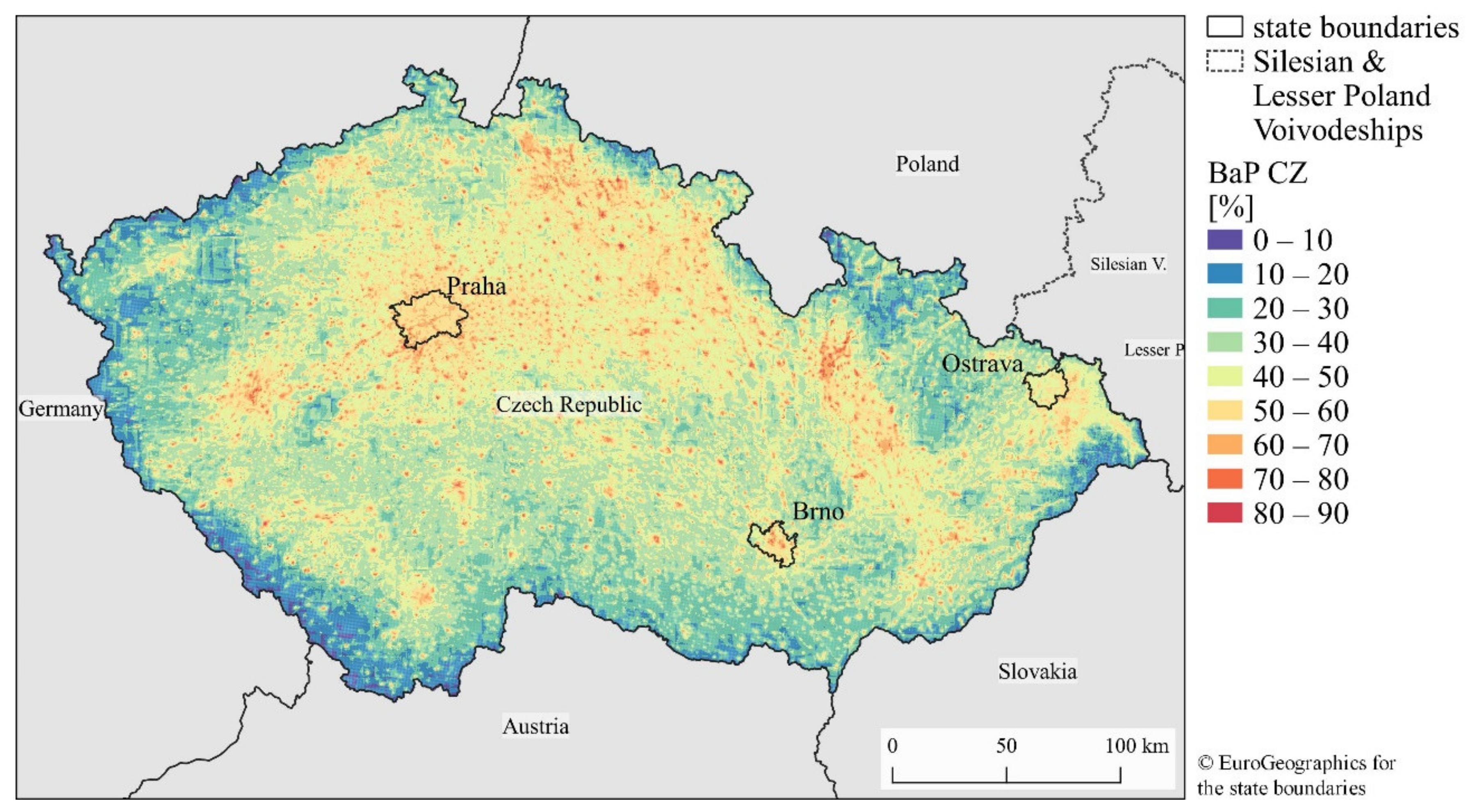1. Introduction
Polycyclic aromatic hydrocarbons (PAHs) are ubiquitously distributed in the environment [
1]. They are common by-products of combustion processes of fossil fuels and wood. PAHs represent a group of substances, many of which have toxic teratogenic, mutagenic or carcinogenic properties [
2,
3]. They affect fetal growth. Prenatal exposure to PAHs is related to markedly lower birth weight [
2] and probably also has negative effects on the cognitive development of young children [
4]. Due to their physical and chemical properties, all these substances can be transported over long distances and deposited in remote areas [
5,
6,
7]. PAHs can bioaccumulate, enter the food chain [
1] and be toxic to the environment.
Benzo(a)pyrene, occurring in the atmosphere primarily bound to particulate matter, has been set as a suitable marker of ambient air pollution caused by PAHs. A European directive has set a target value of 1 ng·m
−3 for the total content of BaP in the PM
10 fraction, averaged over a calendar year [
8], with the aim of avoiding, preventing or reducing harmful effects on human health and/or the environment as a whole. The WHO has not drafted a guideline for BaP, which is a potent carcinogen. The reference level of 0.12 ng·m
−3 was estimated assuming the WHO unit risk for lung cancer for PAH mixtures and an acceptable risk of additional lifetime cancer of approximately 1 × 10
−5 [
9,
10].
Residential combustion as an important source of PAHs and other air pollutants are responsible for the majority of anthropogenic emissions of BaP in Europe. Such emissions are linked to adverse health effects, especially in urban and suburban areas where emissions and population densities are higher [
11]. A modeling study of Europe [
11] stated that it is necessary to assess concentrations of BaP in Europe, as an indicator for PAHs, and quantify their health-related effects. The European Environmental Agency estimates that in 2017, 17% of the EU−28 urban population was exposed to above-target annual mean BaP concentrations; this is the lowest value since 2008. As in previous years, values above 1 ng·m
−3 are predominantly found in Central and Eastern Europe. The highest concentrations were recorded mainly at stations in Poland and the Czech Republic [
12].
Air pollution by BaP is one of the main problems associated with ensuring air quality in the Czech Republic. BaP concentrations exhibit significant intra-annual variation with maxima in winter that are related to emissions from seasonal anthropogenic sources (local heating units) and generally worsened dispersion conditions.
The aim of this study is to assess the current levels and long-term trends of air pollution by benzo(a)pyrene in the Czech Republic, together with their causes. A transboundary contribution to the annual mean concentrations of BaP is also quantified via a modeling-based approach.
4. Discussion
Transport, industry and services combined do not contribute more than 2% to BaP emissions. The main source of BaP emissions in the Czech Republic is overwhelmingly local heating, especially the combustion of solid fuels in older types of boiler constructions with over-fire and under-fire type of burners (
Figure 3 and
Figure 4). Compared to other European countries, the Czech Republic has the second highest average BaP emission per capita from the residential sector (1.5 g/(person·year)). The highest average emission is in Poland (1.6 g/(person·year)) whereas the EU average is 0.4 g/(person·year) [
49].
The main reason for a high share of BaP emissions from local heating in the Czech Republic is specifically the combustion of solid fuel in older type of boilers (over-fire and under-fire). However, these types of boilers are being gradually replaced by low-emission boilers or by other types of heating. In 2018, the share of over-fire and under-fire boilers was estimated to be around 69%. These replacements are being accelerated by the legislative requirements of Act 201/2012 Coll. [
50] that stipulates that after September 2022 only low-emission boilers meeting the parameters of at least 3rd boiler class (as defined in the EN 303-5:2012 [
51]) can be in operation for solid fuel combustion in households. The replacement of old boilers was supported by a subsidy program between 2015 and 2019, with the aim of replacing up to 100,000 high-emission boilers. However, replacement of the boiler itself is not a guarantee of efficient emission reduction if the boiler is not operated properly in accordance with operating instructions.
The range of measured concentration of BaP was from 0.4 ng·m
−3 at a rural regional station to 7.7 ng·m
−3 at an industrial station in 2018. The area where BaP concentrations exceeded the target value was 12.6% in 2018 (
Figure 5). The highest annual average concentrations of BaP have long been recorded throughout the entire Ostrava Region. In this region, there is the highest emission load due to a combination of local heating and the largest share of heavy industry in the Czech Republic. The transboundary contribution in the Ostrava region was estimated to be 40–60% but may be in fact somewhat lower due to model limitations. High BaP concentration values due to the effect of local heating systems have also been monitored in Kladno for a long time. Concentrations exceeding the target value for BaP also occur in Central Bohemia and in a number of municipalities. The values of BaP concentration show that the ambient air concentrations of BaP are high in the Czech Republic in general, which is consistent with the model study of Europe [
11], where the authors pointed out the ambient air concentrations of BaP to be substantially high in Central and Central Eastern Europe but also in some other European regions.
Relatively low levels of BaP have been recorded in large cities, like in the center of Helsinki [
52] and in Porto [
28]. In Porto, transport was identified as the main source of PAHs based on diagnostic ratios. In street canyons in Helsinki, the measured concentrations of BaP were at the same level as those in the urban background and clearly lower than those in suburban detached-house areas. These results indicate that local traffic has only a minor effect on BaP concentrations, compared with the corresponding effect of small-scale combustion. In the Czech Republic, transport is also a minor emission source of BaP (0.8%); nevertheless, levels of BaP concentrations in Prague were higher than in Porto and in street canyons in Helsinki. The higher BaP concentrations in Prague (
Table 1) were caused by regional and long-range transport, especially in the center of the city in areas with a high proportion of remote central heating, where the main emission source of BaP is traffic. In suburban Prague, local heating was as important as it was in suburban Helsinki [
52].
The lowest average annual concentrations are estimated at places distant from direct exposure to emission sources (natural mountain areas). The lowest measured BaP concentrations, ranging from 0.3 to 0.7 ng·m
−3, have been recorded at the Košetice regional station. Nevertheless, these values are still relatively high (
Table 1) and are above the WHO reference value (0.12 ng·m
−3). These relative high values of BaP concentrations at a regional background station pointed out the important role of regional and long range transport in the Czech Republic. The importance of regional transport is related to the high contribution of coal combustion to BaP emissions (about 30–40%) and the long lifetime of BaP derived from coal combustion in the atmosphere as found in this study [
35].
Moreover, no correlation between background BaP concentration at Košetice and emission was found. The same (lowest) value of background BaP concentration in 2008, 2011, 2014 and 2016−2018 supports our conclusion on the combined effects of emission, meteorological and dispersion conditions and transboundary contributions. Based on the CHMI data, the last four years 2015−2018 of the study period are also years with the highest ratio of good meteorological and dispersion conditions and with BaP emissions decreasing after their peak in 2013. The year 2014 can be characterized by a milder winter season and the shortest heating season for many years [
22]. In contrast, the beginning of the study period could be characterized by the greater presence of moderately poor and poor dispersion conditions [
53] and the lowest BaP emissions in the study period (
Table 1).
Since the higher BaP concentrations are a problem in urban and suburban areas due to local heating, we chose five urban and suburban sites in the Czech Republic for the current concentration level and trend assessment. The sixth rural regional site represents the background ambient air concentration in the Czech Republic.
The highest annual average value in urban and suburban sites was detected in 2008, the lowest annual average value of 1.8 ng·m
−3 was detected in 2016, 2017 and 2018 with the widest range, from 0.7 to 3.7 ng·m
−3 in 2017. Nevertheless, the lack of correlation of BaP concentration in the five urban and suburban sites and emissions for the whole Czech Republic (mainly from local heating,
Figure 8) highlights the possible domination of local influences and the influence of meteorological and dispersion conditions.
We found a significant decreasing trend for average concentrations and winter average concentrations. The development of concentrations from selected stations in the Czech Republic between 2008 and 2014 is comparable to the development of PAHs and BaP concentrations presented in the study of [
28] who analyzed data from two suburban sites in Porto between 2004 and 2014. A significant decreasing trend in the framework of their study was also found. A downward trend for all types of stations and at two thirds of total stations over the period 2007−2014 was also presented by EEA [
54]. A significant decreasing trend was found at 22% of European rural and urban stations [
54].
The decrease in concentrations in the Czech Republic is especially noticeable since 2014 highlighting the influence of milder winter seasons in 2014 and 2018, the prevailing good dispersion conditions in 2015−2018 and decreasing coal consumption in the last few years. The significant decrease at two particular stations (Ostrava-Poruba and Kladno-Švermov) that are among those with the highest concentrations in the Czech Republic (and of course those above target value BaP concentration for the whole study period) point also to the effect of improvements in local heating.
Similarly to other studies [
26,
55,
56,
57], the typical seasonal variation for the BaP concentration has been shown. The BaP concentrations for October–March are more than eight times higher than for April–September. For instance, Albuquerque et al. (2016) [
28] found a December–January/June–August ratio of 5 for PAHs for the eleven year study in Porto. The reasons for this are generally known—i.e., seasonal sources as local heating, higher emissions from motor vehicles and less mixing in the atmosphere due to inversions [
28,
57,
58]. During the warmer season, on the other hand, concentrations decrease due to unstable atmospheric conditions favorable towards dispersion, increased chemical and photochemical decomposition of PAHs due to higher levels of solar radiation and higher temperatures and of course also due to decreased emissions from anthropogenic sources [
59,
60,
61].
High values of daily BaP concentrations in winter months associated with local household heating were also recorded during the 2017–2018 campaign measurements in the small settlements of Bochovice, Černíny and Hřivice (
Figure 7), where concentrations of BaP are not regularly monitored and where solid fuel heating predominates. The range of measured BaP concentrations was 0.1–8.0 ng·m
−3 in Černíny, 0.2–9.8 ng·m
−3 in Bochovice, and 1.0–13.6 ng·m
−3 in Hřivice. In particular, measured BaP concentrations in the small settlement of Hřivice were as high as and on some days even higher than in Kladno–Švermov, where some of the highest concentrations of BaP in the Czech Republic were recorded. Every year, concentrations there reach high values and exceed the target value by almost four times. Such high levels of BaP concentrations are caused on the one hand by an extremely high density of buildings, which leads to a higher BaP emission density near the surface, and on the other hand by the fact that the town is located in a shallow valley, which leads to a reduction in dispersion of pollutants during cold days. The limited amount of winter season data obtained by the campaign measurements does not allow for a calculation of annual average concentrations. The target limit value of 1 ng·m
−3 established by European legislation was exceeded in Bochovice, Černíny and Hřivice on 59%, 54% and almost 100% of measurement days, respectively. The measurements in these three small settlements with low–density population clearly indicates that emissions of BaP by local heating influence the short-term BaP concentration in the surroundings. Local meteorological conditions, orography of the populated area and regional and transboundary long-range transport are further factors which influence the ambient air concentration of BaP. In the Czech Republic, due to the rugged terrain, a number of settlements are located in valleys, where there may be a frequent deterioration of dispersion conditions and thus an increase in pollutant concentrations.
The reference level established for BaP by the WHO of 0.12 ng·m
−3 was exceeded at all monitoring sites each year. The target value of 1 ng·m
−3 is set by a European directive (EU, 2004) with the aim of avoiding, preventing, or reducing harmful effects on human health and/or the environment as a whole. During the period of 2012–2018, 35–58% of the urban population in the Czech Republic was found to be exposed to BaP concentrations exceeding the above mentioned target value. The lowest number of inhabitants living in the above-target areas was estimated to be in 2018. The highest number of inhabitants (58%) exposed to above-target concentrations of BaP was estimated for the years 2012 and 2017. On average, only 7% of the population lived in the areas with the lowest concentration of BaP between 2012 and 2018. BaP is carcinogenic to humans and has been considered a good indicator for the assessment of risk to human health associated with exposure from PAHs found in the environment. The individual carcinogenic potencies of PAH in relation to BaP can be expressed through the BaP equivalent concentrations (BaP eq.) and evaluation of BaP alone will probably underestimate the carcinogenic potential of the PAHs mixtures [
28,
62]. The uncertainty of the map is a result of the inadequate number of measurements at rural regional stations and the absence of more extensive measurements in smaller settlements in the Czech Republic, where the air pollution by BaP would demonstrate the fundamental effect of local heating units. In addition, the maps are prepared with a resolution of 1 × 1 km and therefore cannot take into account the local fragmentation of the terrain, which in the case of settlements located in valleys affects the levels of pollutants [
63]. Thus, assessment of the interannual changes in the territory affected and population exposed to above-limit concentrations of BaP will also be accompanied by a greater margin of error.
5. Conclusions
A complex analysis of air pollution from BaP in the Czech Republic was carried out. Ambient air BaP concentrations and their long-term trends were studied to assess the level of BaP in the Czech Republic. The calculated emissions of BaP and modeling of the transboundary contribution to the annual mean concentrations of BaP were quantified to present the causes of BaP air pollution.
The measured concentrations of BaP are high due to high emission load from the combination of local heating and heavy industry in the Czech Republic. The residential sector is responsible for more than 98.8% of BaP emissions.
Many people (50% on average) in the Czech Republic live in the area where the BaP concentrations are above the target value set by a European directive with the aim of avoiding, preventing, or reducing harmful effects on human health and/or the environment as a whole.
On the basis of the observations in small settlements described above, where BaP concentrations are not regularly monitored and where solid fuel heating predominates, it can be assumed that in small settlements, carcinogenic BaP levels may reach high levels in the short-term. Above-target values where BaP is not routinely measured can also be expected in similar municipalities with a high proportion of local heating using solid fuels. Consequently, the fraction of people living in the above-target value areas will be higher than presented.
Due to the high number of small municipalities and particularly due to the high costs for laboratory analyses and limited capacity of the laboratories, the number of measurement locations will always be limited, and therefore it is desirable to specify in more detail data on emissions and to provide substantial support to modeling.
The transboundary contribution to annual average concentration was estimated to be between 46% and 70% for most (80%) of the territory of the Czech Republic. The contribution of Czech sources can exceed 80% in residential heating hot spots. Results are nevertheless subject to limitations of the modeling approach used—it is likely that the transboundary contribution to BaP concentrations in the Czech Republic was overestimated by a factor of 1.5. Apart from residential heating, two other categories of Czech sources with relative contribution to annual local average concentration exceeding 10% were identified: road transport (large cities and vicinity of major roads) and coke oven plants in the Ostrava agglomeration.
The typical seasonal variation for the BaP concentrations has been shown. The BaP concentrations for selected air quality monitoring stations for October–March were more than eight times higher than for April–September. This is in line with the composition of emission sources in the Czech Republic, with the dominance of the local heating sector and with the different influence of meteorological and dispersion conditions in the colder and warmer parts of the year connected with the atmospheric stability and chemical properties of BaP.
We found significant decreasing trends for average concentrations and winter average concentrations. No correlation between background BaP concentration and emission was found. BaP concentration development in the Czech Republic has been influenced by the combined effect of total emission, meteorological and dispersion conditions and transboundary contributions.
The significant decrease at two particular stations belonging to those with the highest concentrations in the Czech Republic also point out the effect of improvements in local heating infrastructure. To conclude, even assuming generally good dispersion conditions and milder winter seasons in future, a significant reduction of BaP emissions is needed to reach the target value for BaP in the Czech Republic.
